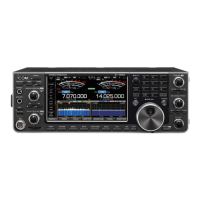4
RECEIVING AND TRANSMITTING
1
2
3
4
5
6
7
8
9
10
11
12
13
14
15
16
17
18
19
20
21
4-3
Using the Twin PBT
1. Rotate
CLR
inner (PBT1) and outer (PBT2)
in the opposite direction from each other.
2. Hold down
for 1 second to display the
current passband width and shift frequency.
• Opens the FILTER screen.
3. To close the FILTER screen, push
.
NOTE: While rotating
CLR
, you may hear noise.
This comes from the DSP unit and does not indicate an
equipment malfunction.
PBT2
PBT1
PBT2
PBT1
PBT2
PBT1
PBT is OFF
Cutting the
lower passband
Cutting both higher and
lower passbands
IF center frequency
Interference
Desired
signal
Passband Passband
Interference Desired
signal
Interference
IF center frequency
Passband center frequency
SFT: Shift value
BW:
Passband width
InformationL
• Match both the
CLR
(inner) (PBT1) and
outer(PBT2)ltersbeforeoperatingtheTwinPBT.
• Rejects interference of both higher and lower
passbands.
• If you rotate the control too much, the received
audio may not be heard because the passband
width is too narrow.
• Displays the passband width and shift value.
• Hold down
CLR
for 1 second to clear the
PBT setting.
• The PBT is adjustable in 50 Hz steps in the SSB,
CW, and RTTY modes, and 200 Hz in the AM
mode. In this case, the center shift value changes
in 25 Hz steps in the SSB, CW, and RTTY modes,
and 100 Hz in the AM mode.
• Rotating both the inner and outer controls together
to the same position shifts the IF left or right.
SSB, CW, RTTY, PSK and AM modes
To reject interference, the Twin PBT (Passband
Tuning) narrows the IF passband width by
electronically shifting the IF frequency slightly above
or below the IF center frequency. The IC-7610 uses
DSP for the PBT function.
CLR
Filter width Shifting value
Passband width
(Duplicated with PB1 and PB2)
Selected
IFlter
• When rotating
CLR
• The FILTER screen when rotating
CLR

